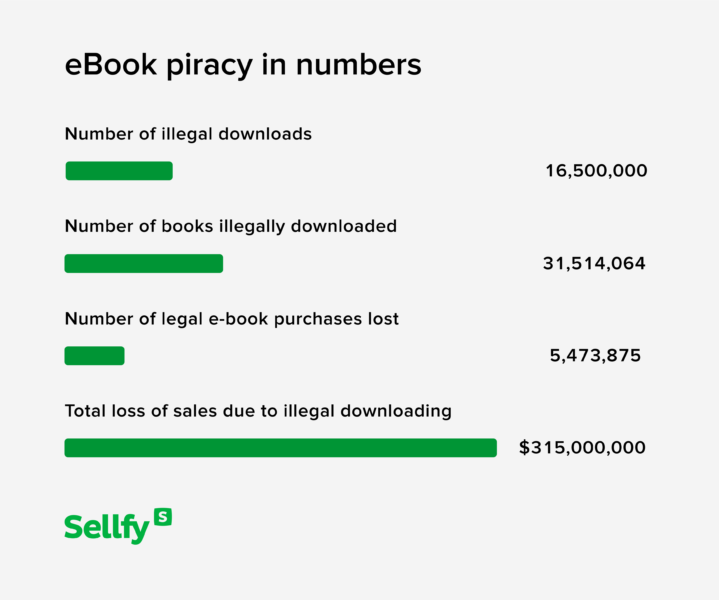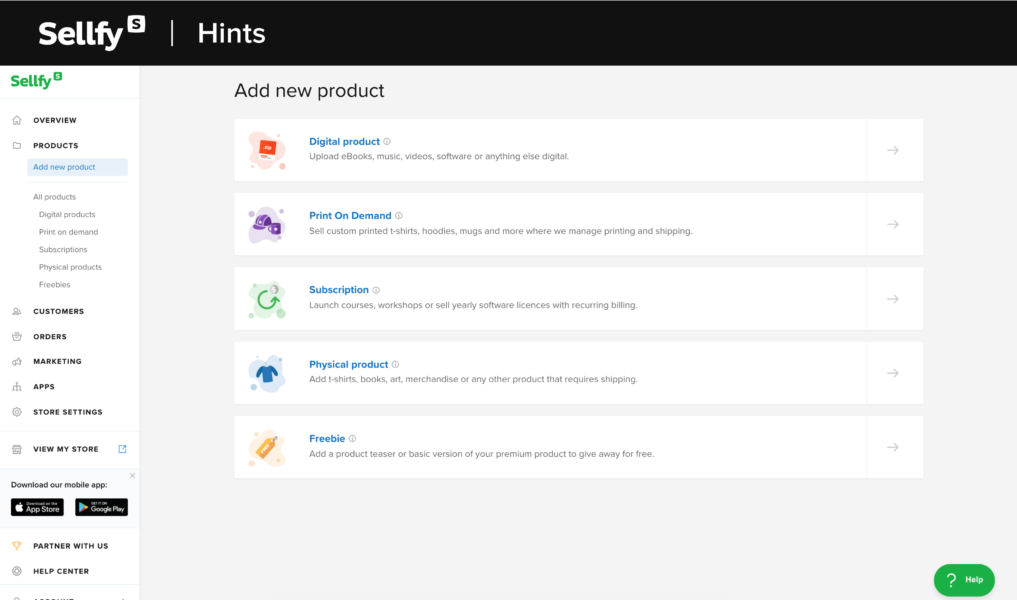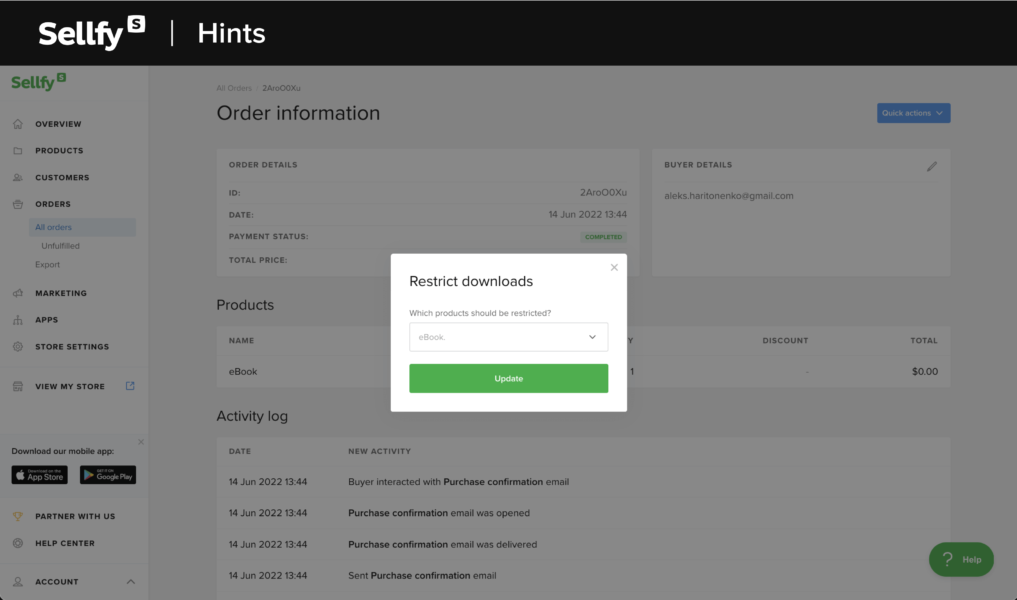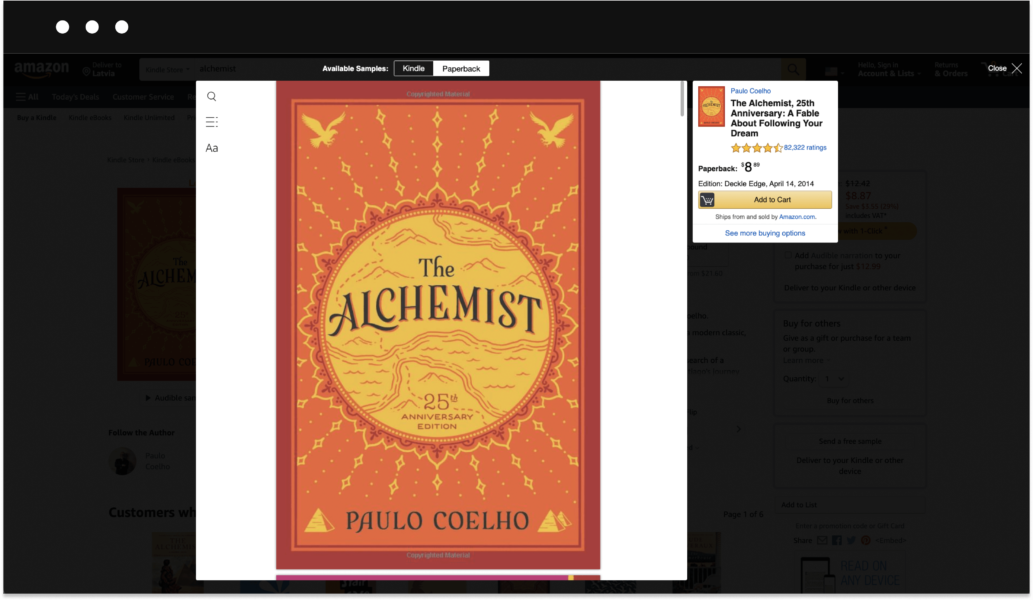Fighting eBook piracy: 9 ways to protect your eBook

With projected revenue of US$17.04bn in 2025, there’s no doubt that the eBook market is on the rise.
Unfortunately, eBook piracy is not falling far back.
This issue is progressively affecting more and more publishers, writers, and self-published authors who are constantly looking for new and better ways to protect their eBooks from thieves and scammers.
In the beginning, it might not seem like such a big issue. But eventually, it can cost you potential sales and loss of revenue.
No need to fret as we’re here to help you tackle this issue!
We’ve taken the time to do our research and gather insights from authors who are not just selling eBooks online but also successfully fighting online piracy. As a result, we’ve compiled a list of 9 essential steps you should take to protect your eBook before publishing.
How common is eBook piracy?
The bad news from the eBook publishing world is that according to the latest statistics eBook piracy has continued to bloom over the past several years. And it doesn’t look like the situation is going to change anytime soon.
According to Forbes, millions of dollars in publishers’ income are lost as a result of eBook piracy.
Here are some latest eBook piracy statistics:

Long are gone the days when you could just shut down a static website full of pirated eBooks. Now, books are distributed via private Facebook Groups, LinkedIn’s SlideShare platform, Scribd, Google Play, and Google Drive.
Plus, you don’t actually need any special skills to “put your hands” on almost any book you want.
You can check it yourself:
In some cases, it takes nothing more than a simple Google search to illegally download a pirated copy of your book.
The bottom line is that eBook pirates are getting smarter.
9 Ways how to protect your eBooks from sharing
The good news is that while some people are figuring out new ways to pirate content, others are coming up with better ways to protect it.
Without further ado, here are some things you can do to protect your eBook from piracy.
1. Choose the right file format for your eBook
Choosing the right format depends on how are you going to distribute your eBook. There are two main options:
- Major online retailers.
- Your own website or online store.
In case you’re planning to sell on platforms like the Amazon Kindle, you’ll have to choose between MOBI, AZW, or AZW3.
Yes, EPUB is considered an industry-standard format for eBooks. But, the fact that this format isn’t supported by Amazon Kindle actually helps fight eBook piracy. While it’s possible to convert files to a compatible format it requires extra effort which might scare off at least part of the scammers.
The situation is a bit different when we’re talking about selling ebooks from your own website as you have to take extra steps to be able to defeat piracy. That’s why the best option here is to convert your eBooks into PDF format. It’s one of the most secure file formats as it supports data encryption and allows you to personalize the user access level.

And, the good news is that if you sell eBooks with a platform like Sellfy, you can even get PDF stamping to help you protect your digital content further.
2. Restrict editing of your eBook
Once you convert your eBook to PDF format, you can use different Adobe features to restrict the editing and copying of eBooks. While it doesn’t necessarily save your eBook from illegal distribution, it can greatly reduce the risk of unfair use of your intellectual property.
Luckily, Adobe gives you several tools that can help you protect your books.
For example, here’s an easy way to restrict the editing of your eBook:
- Convert your eBook to a PDF.
- Go to the Security tab from the Documents Properties dialogue box.
- Check the box that says, “Restrict editing and printing of the document”.
- From the Security Method drop-down menu, select all desired restrictions. For example, you can forbid copying text and images.
- Press OK and save your PDF.
3. Use a safe service to distribute your eBook
The easiest way to prevent eBook theft is to choose a trustworthy eCommerce platform like Sellfy. Building an online store for your eBooks is a great choice for someone who’s looking for seamless digital file delivery and complete control over the eBook store.

Here’s why you should choose a platform like Sellfy:
- State-of-the-art file security & eBook protection
- Possibility to sell EPUB & PDF files
- PDF file stamping
- Unlimited bandwidth & file storage
- An online store with built-in marketing tools
- Safe and clean file delivery
- Mobile-first design
- No transaction fees
- 24/7 customer support
- Multiple payment options
You can be absolutely sure that your eBooks will be safe with Sellfy as they’ll be hosted on a secure cloud server. Moreover, Sellfy has an automatic IP-based security system in place that will help prevent fraudulent transactions.
A lot of successful self-published authors are already using Sellfy to distribute their eBooks—Amel Aitouche and EfikZara, just to name a few.
4. Stamp buyer’s email address with PDF stamping
One of the greatest PDF eBook protection features available is called stamping. A PDF stamp or a watermark is a security measure that has proven to be a successful method to protect your eBooks from theft.
The feature literally stamps the buyer’s email address at the bottom of every single page of the document—it cannot be edited or removed. It’s done to discourage buyers from sharing or reselling your eBook elsewhere online as their credentials will become visible to everyone.
The best news is that if you choose Sellfy as a platform to sell your eBooks, digital watermarks will be available to you at no additional cost.

5. Password protect your eBook
Another easy way to fight eBook piracy is password protection. Actually, there are several options here. For example, you can send an email with a password when someone purchases a copy of your eBook. This way you can be sure that only the buyer has legitimate access to your eBook.
You can also change the password for each buyer (e.g. use a purchase reference). No, it’s can’t stop your customers from sharing their passwords with other people, but it will prevent any illegal downloads.
6. Use product pre-ordering to protect your eBooks
Sometimes, in order to discourage your audience from stealing your content, you have to get really creative.
One of Sellfy’s sellers came up with a great idea on how to protect digital products from piracy by using one of the features offered by Sellfy—product pre-ordering.
Unexpected, right? Let me explain:
Product pre-ordering allows you to sell as many copies of your eBook as you like before you actually list them in your store. Plus, you could also motivate the audience with some special offers. Once, you get enough pre-orders, you can finally give your customers access to the eBook they’ve already paid for and list it in your store for others to purchase.
With this strategy, you can be sure that none of the customers that have pre-ordered your book will share as they simply won’t have access to it before you get enough orders.
7. Limit your eBook downloads
If you’re selling your ebooks from your own website or use an eCommerce store like Sellfy, you can try limiting download attempts for separate purchases.
It means that in case any of your unfaithful customers decide to share the download link with others, it simply won’t work!

But what’s the perfect download attempt number for an eBook?
With Sellfy, the download attempts for each product file are automatically limited to 5 per purchase. And there’s a reason for that:
- A customer might want to download files to different devices.
- A customer might damage the device they had saved the file on, or simply lose the file.
- A customer simply needs several attempts to download the entire file due to their internet connection or other factors.
However, you must keep in mind that limiting the number of downloads still won’t stop unfaithful buyers from sharing the file itself.
8. Register a copyright for your eBook
As an aspiring self-published author, you might already know that there’s a law that automatically protects any digital content you produce (including eBooks). What you might not know is that this law isn’t very helpful when it comes to actually protect your ownership rights in case of copyright infringement.
In other words, even though there is no requirement to register a copyright for your eBook, you cannot file a lawsuit to protect your work unless you’ve registered it.
I agree that it doesn’t make a lot of sense, but these are just straight facts.
Luckily, there’s a simple solution—you need to register your eBook and include a copyright page.
Registration of any copyright is much easier than it seems. You just have to send an electronic or physical application to the United States Copyright Office. It’ll cost you anywhere between $35-$55, but you should keep in mind that the process can take between 6 and 15 months.

Once you finalize the registration it’s highly recommended to include a copyright page in your eBook. Here’s a simple example of a copy that you can use on the page:
Published by Jane Doe
© New York
All rights reserved. No part of this book may be reproduced or transmitted in any form, including photocopying, recording, or by any information storage and retrieval system, without written permission from the author.
9. Set up Google alerts
Not a lot of people know about this, but setting up Google alerts can actually help you monitor how and when your eBook (or any other intellectual property) is being used online.
Here’s how it works:
First, you have to decide which part of your book you’d like to track. Some people choose specific terms, quotes, or names, others simply use the title of the eBook. Then go to the Google Alerts setup page and enter the words in the “Create an alert” bar. Putting your entry in quotation marks will help to refine the search results.

Once done, you’ll be able to follow up on all cases when your intellectual property is copied and used without your permission.
How does it help?
Well, the sooner you find out, the sooner you can take action to take down pirated content.
Bonus tip: my eBook was pirated, what should I do?
Now that we’ve talked enough about how to protect your eBooks from piracy, let’s take a look at what you can do if you find out that someone has already stolen your work.
While you can start by contacting the website where your eBook is illegally listed, the chances for you to get a reply are pretty weak.
However, if you’re absolutely sure that someone has stolen your eBook and is distributing it without your consent, you’re entitled to file a DMCA notice to take out your eBook or even shut down pirate sites.
A DMCA (Digital Millennium Copyright Act) notice informs a website owner, a search engine like Google, or a hosting company that they are hosting or linking to material that infringes on a copyright. During the last couple of years, a DMCA notice has proven to be one of the most effective tools in reducing book piracy. The reason for that is that scammers may face actual legal consequences in case they fail to comply with the copyright law.
Here’s how it works:
You can file a DMCA notice yourself, or turn for help to one of the DMCA agencies to do it for you. Once the official copyright notice reaches the company or the web host and notifies them of the copyright infringement, they will be forced to take down your eBook. However, if they fail to comply, the whole website might shut down altogether.
Is DRM really helpful for fighting eBook piracy?
When it comes to protecting your eBooks from piracy, eBook DRM or Digital Rights Management, is probably one of the things you think of first.
Simply put, DRM uses technology to protect your eBooks from piracy. A lot of publishers and eBook retailers are using it as a weapon against piracy and theft.
That sounds like a great idea… Or does it?
It’s not a secret that platforms like Amazon Kindle are using DRM to protect eBooks from copying and sharing. However, the system is far from perfect.

Anyone who knows how to use Google can find DRM removal tools that will literally break any DRM protection within minutes. Really, just look it up—you’ll be surprised how easy it is.
The other problem is that if you decide to use DRM protection, your won’t be selling your eBook—you’ll be renting it. And we’re not just talking about the inability to share or lend a book to a friend, you may even be able to restrict access to an already purchased copy.
Can you imagine Joan Rolling coming into your house and taking away all of your printed Harry Potter books? Well, that’s what restricting access to a purchased eBook feels like.
The bottom line is that while Digital Rights Management clearly gives you much more control and a sense of protection, it can also stop a lot of potential readers from buying your book.
Why shouldn’t you overprotect your eBooks?
This might sound a bit controversial, but I’m still going to say it:
As an eBook author, you should actually celebrate the moment when someone steals your work.
I know a lot of writers would disagree with this, but let me explain:
Once upon a time, a famous author called Paulo Coelho has decided to personally release a ‘pirated’ translation of “The Alchemist”. His book sales have jumped from 1000 copies a year to 100,000 the next year and 1,000,000 in the third year.

While it seems counterintuitive, eBook piracy can actually help you boost exposure! And that’s exactly what you need to get more eBook sales.
Then again, you might say that you’re losing potential customers when someone is illegally downloading your book.
That’s not completely true.
Illegal eBook downloads can’t really be counted as lost sales. The sad truth is that people who choose to get “free” eBooks aren’t the ones who would pay for them even if it were the only option.
The only thing you should really worry about is someone illegally making a profit from your eBook. But, we’ve already covered various ways how you can catch and fight it.
Final words: can you prevent eBook piracy?
The sad truth is that selling your creations on the internet will always make you a bit susceptible to having your work stolen. But, there are still things you can do to protect your eBooks. For example, use a safe distribution platform (e.g. Sellfy), choose the right file formats, register copyrights, and file a DMCA notice in case find out that someone’s illegally distributing your eBooks.
So, good luck to anyone who’s stepping on the treacherous road of fighting eBook piracy, and may the Copyright force be with you!
FAQ: fighting eBook piracy
What is eBook protection?
eBook protection refers to the various measures designed to prevent unauthorized access, distribution, and copying of digital books.
This can include using digital rights management (DRM) technologies, encryption, watermarks, or other methods to make it difficult for readers to share or copy the content without permission.
eBook protection is important for authors and publishers who want to protect their intellectual property and ensure that they are paid for their work.
How do I stop eBook piracy?
Preventing eBook piracy is a challenging task, but there are some steps you can take. Consider using digital rights management (DRM) technology to protect your eBooks from unauthorized copying.
If you’re selling your eBooks from your own website or an eCommerce store like Sellfy, you can try limiting download attempts for separate purchases. With Sellfy, the download attempts for each product file are automatically limited to 5 per purchase.
Where can I sell my eBooks?
You can sell eBooks through Sellfy. That way, you’ll be able to have complete control over your business. First, create an account on the Sellfy platform and set up your eBook store. Then, start uploading your products, photos, and any other information.
Once your eBooks are ready, you can set your own prices and publish them on your store. Sellfy will handle the payment processing and automated delivery of your products.







